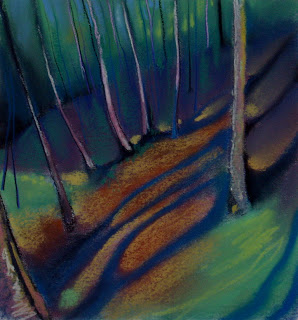Relevant Thoughts in Italics.
Here we are, in a quiet wood, set back from the dog-walkers' track, but NOT FAR ENOUGH. A painter stares at something and makes decisive coloured smears and marks on paper saturated with such activity. Clearly ENGAGED in what she is doing.
Enter, Man In Tracksuit.
MAN: You're drawing.
PAINTER: Yes.
Well, painting, but let's not quibble.
MAN: You drawing the bridge?
PAINTER: I can't see the bridge.
Can he see the bridge from here? What kind of eyes does he have?
MAN: Most people draw the bridge.
PAINTER: Not from here, they don't.
(Feeling bad for being snarky, PAINTER continues): I'm painting the fallen tree.
MAN: Which one?
 |
| Bridge K Howell Pastel on Paper 21 cm x 14 cm |
PAINTER: The one on its side. The one that looks a bit like my painting.
MAN: Uh.
A long silence ensues.
MAN: You're using pastels.
PAINTER: I am indeed.
Terrier licks a half stick of prussian blue. Man in tracksuit is oblivious.
MAN: Do you like pastels, then?
PAINTER: I do.
MAN: I find them messy.
PAINTER (regarding own purple fingers): Messy can be good. I like messy.
MAN: I can draw.
PAINTER: I imagine you can (Wipes prussian blue stick on denims).
MAN: I have a GNVQ in Art and Design.
PAINTER: Ah (Reaches for permanent red).
MAN: I have lots of drawings, at home.
PAINTER: Hmm.
MAN: Most of them are from 2005 or before.
PAINTER: I see (Reaches for light yellow).
MAN: It's finding the time, you know? To draw.
PAINTER: It doesn't happen unless you do it, does it?
MAN: Life is busy.
PAINTER (whose life is obviously comprised of more hours than the usual twenty-four): Sometimes you have to make time, really.
MAN: Too much on, you know?
PAINTER is silent. Terrier sniffs ochre stick.
MAN (indicates PAINTER's work): That's not bad, really.
PAINTER (expression could be construed as a smile):
Cheers.
How fortunate that I'm painting this specifically for your approval. How favoured and fulfilled I feel.
MAN: It's very peaceful here.
PAINTER: Hmm.
It certainly was.
MAN (indicating a direction): Know where I'll get to if I carry on this way?
PAINTER:
I really don't like to say... Eventually, you'll reach the road.
MAN: Ah. Well, enjoy your time.
PAINTER: You as well.
As long as I have your blessing oh magnanimous one who walks with the scruffy dog. And I apologise with every fibre of my being for having time when clearly more talented, driven and able people are without such resources.
Truly, a most entertaining excursion.










































